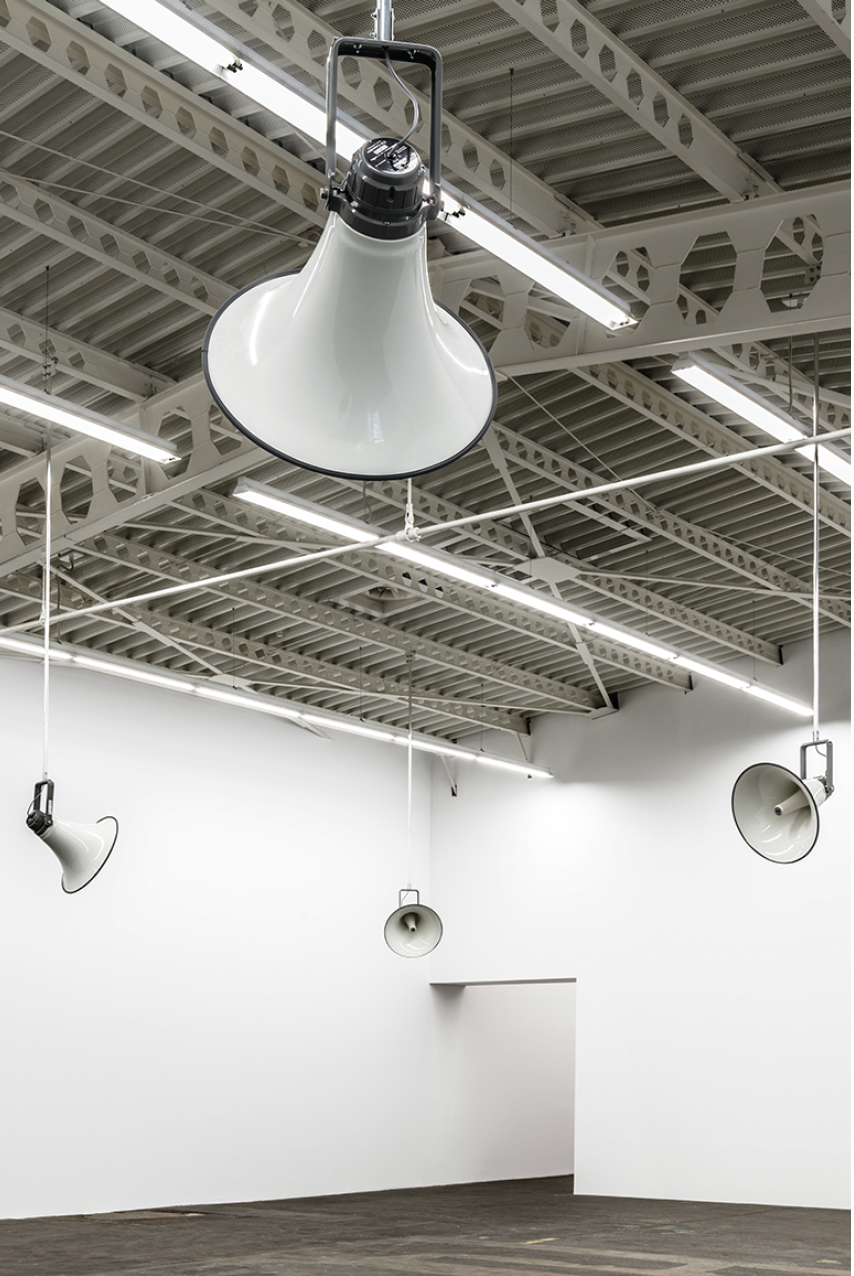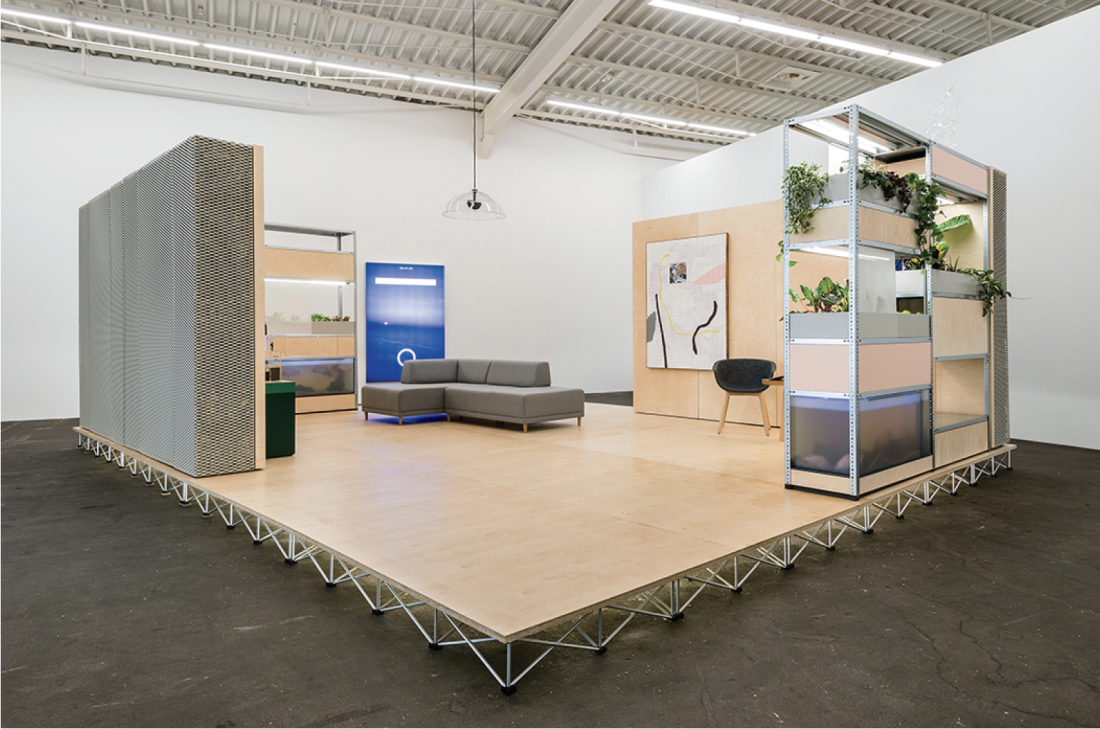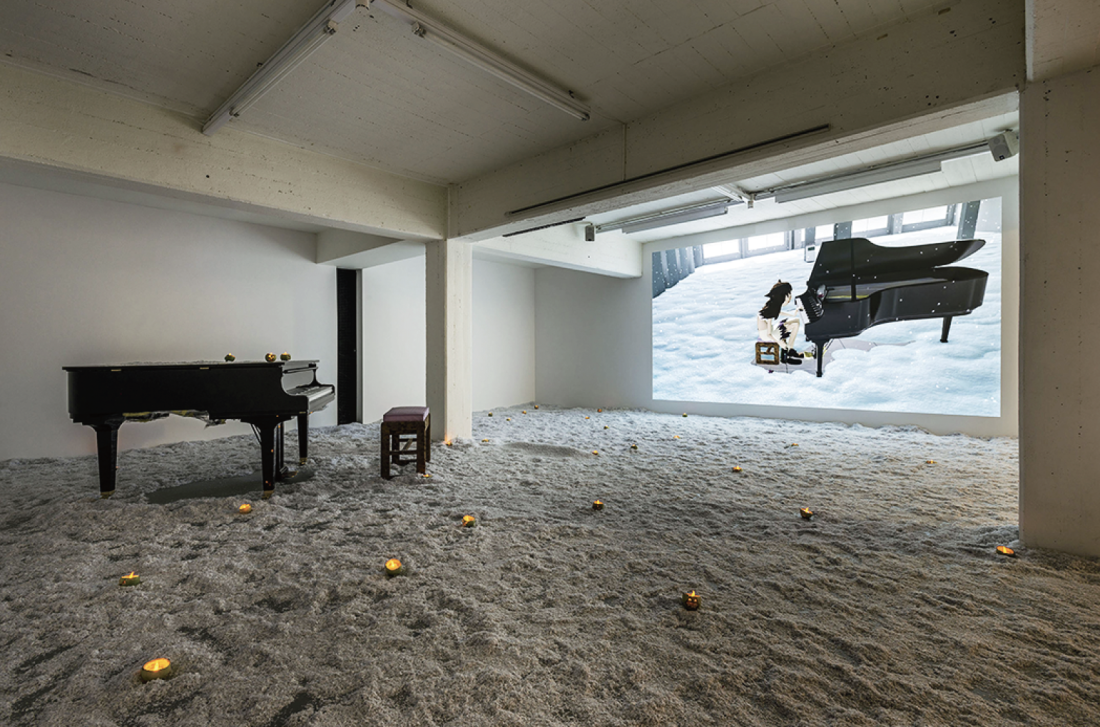“moving in every direction. Environments - Installations - Narrative Spaces”
One of the successes of “moving is in every direction . Environments – Installations – Narrative Spaces,” a recent survey of iconic, and perhaps yet-to-be iconic, installation art at Berlin’s Hamburger Bahnhof Museum, is the inclusion in the exhibition of the institution’s permanent works, which came to function as active participants in a dialogue about narrative structures and, more generally, how art historical narrative is made. Quoting Gertrude Stein, curators Anna-Catharina Gebbers and Gabriele Knapstein proposed that the story flows “in every direction.” Indeed, the presentation did not unfold chronologically but in a series of juxtapositions that set each work in a new light. Where the presence of Joseph Beuys renders Bunny Rogers’s tween-flavoured installation, Mandy’s Piano Solo in Columbine Cafeteria, 2016, superficial and breezy, other canonical pieces feel trendy in light of current fashion. A recent mania for ferns in gallery spaces makes Marcel Broodthaers’s Jardin d’hiver, 1974, appear remarkably chic, for example, thus ironically subsuming his critique of bourgeois aesthetic. History is not a chronology but a formalized relationship to memory and oblivion, and perhaps it’s this particular fact that comes to light as the discursive threads loosen with some of the younger artists on show.

Susan Phillipsz, War Damaged Musical Instruments (Shellac), 2015, Staatliche Museen zu Berlin, Nationalgalerie. © The artist and Konrad Fischer Galerie.
It is Rogers’s piece that stands out in the exhibition, not for its strength but for its omnipresence. Not only was it the piece most often used to advertise the show, in addition to Broodthaers’s, it was also the work that dispersed itself throughout the entire building. During the opening many people wandered through the museum with large, white flakes in their hair. As you got closer to the artist’s subterranean installation, the frequency of the flakes increased; young and old, male and female, dressed most often in the prerequisite art-opening black, were dusted in festive confetti, though the artist’s subject matter is anything but fun. Rogers reconstructed a snow-filled CGI version of Columbine High School’s cafeteria. In the centre stood a piano at which sat a barely clad computer-animated girl practising an Elliot Smith song and drinking a glass of wine. The gallery mirrors the setting of the animation. A piano stands amidst heaps of “snow,” though here, small electric candles are nestled into the paper dunes. At the entrance a motion sensor releases snowflakes on anyone walking through. During the opening the device seemed overloaded by the sheer number of people coming in and out, so to achieve the snow-flecked effect, individuals nestled into the paper or threw it up over themselves. This enthusiastic interaction was not limited to the opening. A week later I walked in on a girl dancing through the flakes while her boyfriend filmed on his cellphone.
The work is a product of connections woven among Internet subcultures, suicide (Elliot Smith took his own life at age 34) and teenage melodrama. Rogers found herself exploring the bizarre online aftermath of the massacre, which included teenage girls emotionally and sexually fixated on the young male shooters. Unearthing these links brings depth to a work that seems glib at the outset, especially when removed from the other pieces Rogers created as part of her exploration of a post-Columbine Internet world. And though it’s appropriate that the room is charged with the awkward erotics of a middle school “sock hop,” the piece seems ultimately to further the insular trivialization that Internet subcultures already do so well. This begs the question: Are the issues and ideas more interesting than the experience of the art? Does the audience who curls up in the snow know what the work is about? Is there a way that they should interact with the installation? The easy answer is that the viewer finishes the work, that viewership cannot be prescribed. But this death-of-the-author avoidance of responsibility can quickly sound like a trope and render the piece cynical. In the end, Rogers’s sources for the work serve as a more sobering and evocative encounter with the contemporary, Internet-informed, coming-of-age experience.
The title of the survey, “moving is in every direction,” rings as especially canny when you consider that exhibitions no longer exist as discrete experiences in a gallery space, but as an extended network linked to Instagram, concomitant public events, fashion and advertising. It’s this constellation in which Rogers, as a young woman who was brought up with the Internet, circulates. Starting with her GeoCities-styled .ru website (a domain suffused with its own wealth of associations and stereotypes) and extending to social media, her ingenue persona is part and parcel of the art world’s current fixation on youth that parallels the easy marketability of the girls of pop music—the likes of Iggy Azalea and many others. Buttressed by cultural theory, the portrayal of young female drama in art becomes a particularly titillating but appropriately intellectualized product.

Christopher Kulendran Thomas in Zusammenarbeit mit Annika Kuhlmann, New Eelam, 2017. Courtesy the artists. © Nationalgalerie im Hamburger Bahnhof, SMB / Jan Windszus.
Christopher Kulendran Thomas’s practice also extends into the digital domain, though he does so through the simultaneously idealistic and less than idealistic proposition of a networked, fluid housing community. Thomas proposes a business plan to provide homes for today’s mobile worker in the so-called post-labour economy. New Eelam, 2017, the name of this hypothetical business, offers, at a flat monthly rate “equivalent to the cost of rent,” access to a variety of housing in the world’s “most dynamic neighbourhoods.” Apart from a website that acts as an advertisement for the idea, the gallery offerings include installations that function something like corporate showrooms. Thomas builds sleek, IKEA-like living spaces complete with mirrors, houseplants, iPads, aquariums and herb gardens. Large LED screens play promotions or bizarre online video games where all the characters stand around naked, while sofas and armchairs are scattered around for people to lounge.
Conceived as a subversive Marxist rewiring of the technologies of capital, the idea may in fact render the mobile worker’s position even more precarious as they engage in a jet-setting lifestyle born of necessity. Thomas himself admits his goal isn’t to topple the system but to use its own tools to build alternative infrastructures for the growing freelance class. Making a living from freelance labour, the untethered worker becomes fully dependent on the forces prompting her to move from place to place. Because she lacks the stability to build community, family or home, the idea of travel as an edifying activity is eclipsed by ideas of insecurity and migration.
Of the permanent works, it is Joseph Beuys who presents the starkest contrast to the ambivalent complicity of the younger generation, though there are also some similarities. Like Rogers and Thomas, Beuys realized that the artwork is a complex event, but his pre-Internet social network was grounded in a pseudo–religious creation myth: he claimed to be rescued by Tartars after his Luftwaffe plane crashed in Crimea. Portraying himself as a near shamanic figure, he conceptualized art as having a healing and socially transformative effect—a belief that materialized into initiatives such as the International Free University. Whether or not you like Beuys’s mythologizing proclivities, his inclusion gives the exhibition a weighty centre of gravity; he acts as a reminder of a time when ironic unpacking, or repacking, was not yet the strategy of choice. Tallow, 1977, for example, is a series of monumental sculptures made by casting the architectural dead space under a bridge. They are made from Beuys’s trademark material: fat. Their heavy scent thickened the room’s climate-controlled air, and their drooping, tired weight is held together by rusted metal belts. Time is rendered onerous, an accumulation rather than a moving forward. The sculptures evoke a still sobriety not found in the newer works. Today, such sincerity risks looking less than clever, or, worse, naïve. Moreover, sincerity is not particularly reproducible; “going viral” would render it quickly a cliché.

Bunny Rogers, Mandy’s Piano Solo in Columbine Cafeteria, 2016, animated film, Lavender Piano Beach (inside – Two pairs of Mandy Socks), 2016, installation. Courtesy the artist and Société. © Nationalgalerie im Hamburger Bahnhof, SMB / Jan Windszus.
There are also projects that fill the space between the historical weight created by Beuys and entrepreneurialism of today’s fluid milieu. The most refreshing of these was the work of Susan Phillipsz, whose complete elusion of the image made hers a space of reprieve from the chaos of visual information. War Damaged Musical Instruments (Shellac), 2015, is an audio piece played through white megaphoneshaped speakers hanging from the ceiling. Each one plays fragmented, unrecognizable excerpts from “The Last Post,” a military call signalling to wounded or separated soldiers that the battle is over. The sound is broken because it is played on the remains of instruments from military history museum collections, some of which are barely usable. The resulting tones come out as moans, whispers or the last breaths of a history that cannot be relived. Emitted at intervals, the sound speaks to an unbridgeable space between past and present, yet acknowledges the lingering effects of what came before. Despite the hectic opening, with the wandering, whitepowdered gallery visitors, Phillipsz succeeded in creating an island of stillness amidst all the movement. Though there is a background story and its relation to the work can be articulated (as it is in videos played in an adjacent room), in the end we are left with the ineffability of history and with the contingency of our efforts to understand our position in time.
Phillipsz’s strength is in her ability to merge historical weight with the sensation of the work. The discursive and the experiential form a poignant relationship with one another, an effect that may prompt us to think of how our current time will be remembered. With potentially all digital information lost, cheap housing eroded, our legacy may lie in the symptoms caused by the toxic chemicals absorbed by the earth and distributed through the entire ecosystem. And it is this often indecipherable accumulation of time that moving in every direction best articulates. What gets remembered, what gets forgotten and how? The answers will decide how the future develops. ❚
“moving is in every direction. Environments – Installations – Narrative Spaces” was on exhibition at Hamburger Bahnhof – Museum für Gegenwart, Berlin, from March 17 to September 17, 2017.
Dagmara Genda is an artist and writer living in Berlin.

